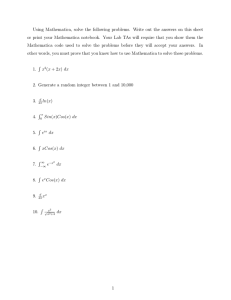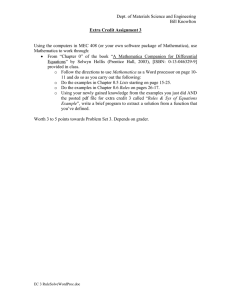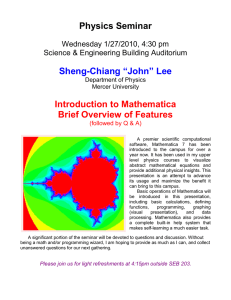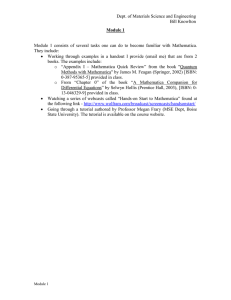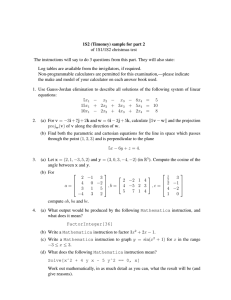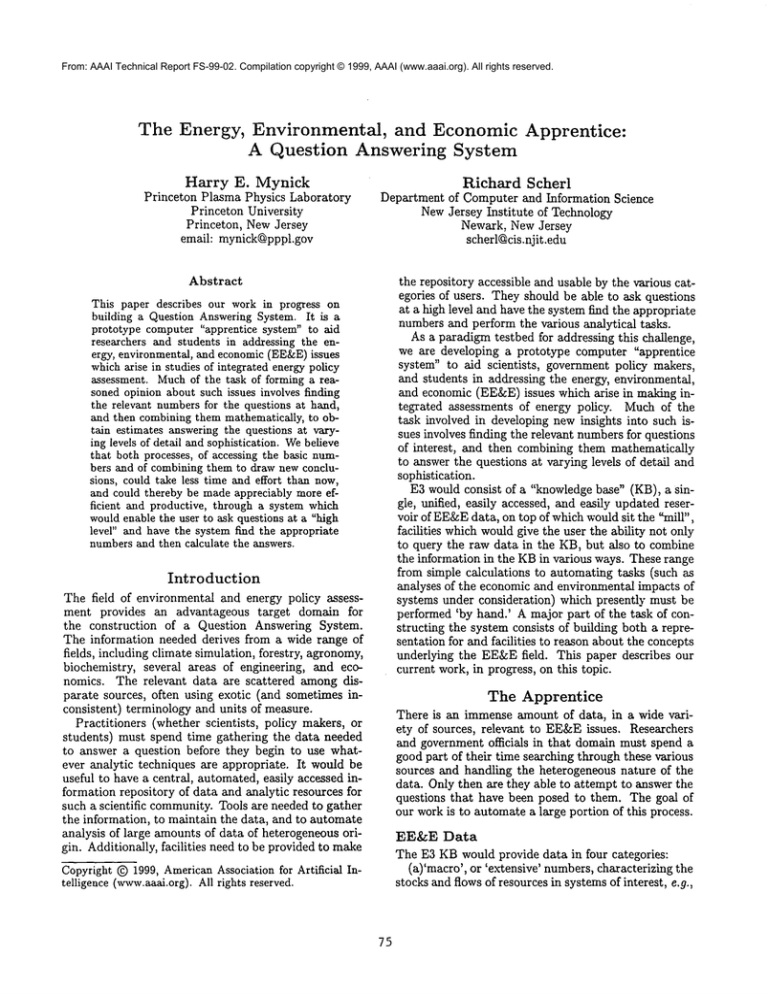
From: AAAI Technical Report FS-99-02. Compilation copyright © 1999, AAAI (www.aaai.org). All rights reserved.
The Energy, Environmental,
and Economic Apprentice:
A Question Answering System
Harry
E. Mynick
Princeton Plasma Physics Laboratory
Princeton University
Princeton, NewJersey
email: mynick@pppl.gov
Richard Scherl
Department of Computer and Information Science
NewJersey Institute of Technology
Newark, New Jersey
scherl~cis.njit.edu
Abstract
the repository accessible and usable by the various categories of users. They should be able to ask questions
at a high level and have the system find the appropriate
numbers and perform the various analytical tasks.
As a paradigm testbed for addressing this challenge,
we are developing a prototype computer "apprentice
system" to aid scientists,
government policy makers,
and students in addressing the energy, environmental,
and economic (EE&E)issues which arise in making integrated assessments of energy policy. Much of the
task involved in developing new insights into such issues involves finding the relevant numbersfor questions
of interest,
and then combining them mathematically
to answer the questions at varying levels of detail and
sophistication.
E3 would consist of a "knowledge base" (KB), a single, 1miffed, easily accessed, and easily updated reservoir of EE&E
data, on top of which would sit the "mill",
facilities which wouldgive the user the ability, not only
to query the raw data in the KB, but also to combine
the information in the KBin various ways. These range
from simple calculations to automating tasks (such as
analyses of the economic and environmental impacts of
systems under consideration) which presently must be
performed ’by hand.’ A major part of the task of constructing the system consists of building both a representation for and facilities to reason about the concepts
underlying the EE&Efield. This paper describes our
current work, in progress, on this topic.
This paper describes our work in progress on
building a Question Answering System. It is a
prototype computer "apprentice system" to aid
researchers and students in addressing the energy, environmental, and economic(EE&E)issues
which arise in studies of integrated energy policy
assessment. Muchof the task of forming a reasoned opinion about such issues involves finding
the relevant numbersfor the questions at hand,
and then combining them mathematically, to obtain estimates answering the questions at varying levels of detail and sophistication. Webelieve
that both processes, of accessing the basic numbers and of combining them to draw new conclusions, could take less time and effort than now,
and could thereby be madeappreciably more efficient and productive, through a system which
wouldenable the user to ask questions at a "high
level" and have the system find the appropriate
numbersand then calculate the answers.
Introduction
The field of environmental and energy policy assessment provides an advantageous target domain for
the construction
of a Question Answering System.
The information needed derives from a wide range of
fields, including climate simulation, forestry, agronomy,
biochemistry, several areas of engineering, and economics. The relevant data are scattered among disparate sources, often using exotic (and sometimes inconsistent) terminology and units of measure.
Practitioners (whether scientists, policy makers, or
students) must spend time gathering the data needed
to answer a question before they begin to use whatever analytic techniques are appropriate. It would be
useful to have a central, automated, easily accessed information repository of data and analytic resources for
such a scientific community. Tools are needed to gather
the information, to maintain the data, and to automate
analysis of large amounts of data of heterogeneous origin. Additionally, facilities need to be provided to make
Copyright © 1999, AmericanAssociation for Artificial
telligence (www.aaai.org).All rights reserved.
The Apprentice
There is an immense amount of data, in a wide variety of sources, relevant to EE&Eissues. Researchers
and government officials in that domain must spend a
good part of their time searching through these ~arious
sources and handling the heterogeneous nature of the
data. Only then are they able to attempt to answer the
questions that have been posed to them. The goal of
our work is to automate a large portion of this process.
EE&E Data
The E3 KBwould provide data in four categories:
(a)’macro’, or ’emensive’ numbers, characterizing the
stocks and flows of resources in systems of interest, e.g.,
In-
75
the amount of cropland in the US, or the number of
Gigatons of CO2 being pumped into the atmosphere
per year.
(b)’micro’, or ’intensive’ numbers, characterizing
technologies or materials out of which systems are built,
e.g., the conversion efficiencies of aeroderivative turbines, the energy per unit weight of dry wood, or the
cost per installed Watt of a coal-fired plant.
(c)’relational’ information, including links between
objects in the KB, which indicate the relationships
which exist among these objects, and equations giving
the Apprentice an understanding of important EE&E
concepts that both it and the user can call upon in
performing analyses.
(d)’support’ information, including help information
on the meaning and use of the symbols and functions
in the system, notes on the proper interpretation of the
numbers in the KB, the source from which they were
drawn, and pointers to useful references and authorities
on a specified topic.
The first step in our research is to develop an ontology
(Gruber 1993), a set of interrelated categories, to organize this material. To make our work compatible with
related efforts, we are utilizing HPKB-UL,the Upper
Level Ontology being used in Defense Advanced Research Projects Agency’s (DARPA)High Performance
Knowledge Base (HPKB) project 1. The HPKB-ULis
the upper-level ontology of the Cyc KB(Lenat & Guha
1989) augmented by some links to the Sensus ontology
(Knight & Luk 1994). HPKB-ULprovides a taxonomy
of about 3000 terms and relations for general terms such
as tangible-object, action, and transportation. It also
defines some relations between them, such as the starting time of an event, the relationship between an object
and its parts, and the borders of a geographic region.
The X3T2 working group of ANSI has adopted HPKBULas the current draft for a standard upper ontology.
Manyof the terms necessary for our ontology, for example, geographical regions, countries: are already defined
in the HPKB-UL. The HPKB-UL, however, does not
include manyspecialized terms necessary for our work,
for example, green house gas emissions and air pollution rates. The categories that we define will be linked
to the concepts in the HPKB-UL
making it_easy~ for us
to disseminate our work.
The
& Fikes 1992) for any information that cannot be directly captured in the OKBCknowledge model. KIF
is a highly expressive language for the interchange of
knowledge among disparate programs. Weanticipate
that as we formalize the domain knowledge for the E3
domain, we will have to make any necessary extensions
to the OKBCknowledge model and investigate
what
combination of the OKBCknowledge model, KIF and
domain-specific extension will be most suitable.
The Implementation
We have constructed an embryonic E3 prototype in
Mathematica, to sharpen our understanding of where
the possibilities and challenges lie in building the system. Mathematica has proven to be a very good environment in which to perform the development thus far.
The capabilities
of a computer-aigebra system (CAS)
like Mathematica are useful in a number of respects,
in organizing and manipulating the heterogeneous kind
of information EE&Ework entails. Mathematica is a
modern, widely used and well supported CAS, with exceUent capabilities for not only symbolic algebra (important for treatment of real problems of a quantitative
nature), but also for graphics (plotting data, drawings,
color etc.) and for the numerical solution of algebraic
and differential equations (which will lend itself well
to incorporating facilities for modeling). Mathematica
cont~ns a sophisticated programming language that in
a unique but systematic fashion incorporates pattern
matchingfacilities (similar to those of Prolog) and facilities allowing ready implementation of object oriented
capabilities (similar to those of Smalltalk and C++).
All of these capabilities are important in the construction of the prototype Apprentice being described
here. Therefore, we are basing our architecture around
the use of Mathematica, but incorporate components
written in other languages that are either already available or that we will write during the course of this
project. Mathematicahas facilities for interacting with
outside software, so that it can call other software,
and programs can be written that call Mathematica
and then utilize the results of a computation performed
within Mathematica.
For the construction of the Knowledge-Base we are
using the Generic Knowledge-Base Browser and Editor
(GKB-Editor) (Karp, Chaudhri, & Paley 1998) developed at SRI. The editor is designed especially to provide a graphical interface to facilitate the development
of complex frame-based knowledge bases. Its facilites
include ones which graphically represent the structure
of the knowledge base as an aid in comprehension, as
well as graphical facilities for modifying, deleting, replacing, and editing frames and slots. The GKB-Editor
is designed to be portable across multiple frame representation systems (FRS) by utilizing the OKBCprotocol which is a set of functions that form a generic
application-program interface to the FRS. Wewill use
the OKBCprotocol in our implementation.
In this environment, the GKB-Editor is utilized as
Knowledge-Base
Most of this information is to be coded in a frame-based
language. Wewill utilize the frame language defined
in the Open Knowledge Base Connectivity knowledge
model (Chandhri et al. 1998). OKBCis an application
programming interface for accessing frame representation systems (FRSs). The OKBCknowledge model defines a frame-based language that is supported by a
large class of FRSs. This language ~d_ll be supplemented
with Knowledge Interchange Format (KIF) (Genesereth
1See http://T.’w~.teknowledge.com/
76
a front end to OCELOT(an OKBCcompliant FRS).
Finally the ORACLEdata base management system
is used as the back end. The frame based language is
translated into a standard relational data base and various operations on the frame base language are translated into SQLcommands. The end result is that all
of the data base technology from the ORACLEback
end is inherited by the knowledge based system (Karp
& Paley 1995).
In[11]:= SI[200HW * 1 yr * .05 $US/kWh* .75]
7
Out[ll]= 6.57 10 $US
In/12]: = IaC[BIG$ISTIG1]
770 $US
Out[12]=
kW
Some Simple Illustrations
In[13]:=notes[BIG$ISTIG1]
0ut[13]:noteA: Numbersfor a biomass-fueled
>
BIG/ISTIGsystem,with a
>
fixed-bedLurgi gasifierwithoutchemical
>
hot-gascleanup,and a 110
>
MW ISTIG unit.
As mentioned earlier, we have developed an embryonic
E3 within Mathematica. Below we give a series of illustrations of accessing and combining information in
the KBas already implemented. Data is represented as
properties on objects. Regions of the world (countries
or states such as US, and N J) have properties such as
energy or area and specializations of those properties
such as year, or type (e.g. fossil,
coal, cropland).
In[l] := energy[US,fossil,coal,
0ut[1]= 19.93 EJ,
In [14]: = energyDensity
[poplar]
19.4 MJ
Out[14]=
kg
1988]
Here,the user’squeryand E3’sresponseare on
lineslabeled
withthe standard
Mathematica
designationIn[i]andOut[i],
respectively
~ointly
referred
toas
[i]below).
In queries[1,2]aresimplerequests
for 2 macronumbers.
To makematters
as simpleas possible
forthe
user,E3 is fairly
relaxed
abouttheorderofarguments,
so that,for example,
query[2]couldalsohavebeen
posedas area[1988,cropland,US].
In [4] is showna
querysomewhatmoreinvolvedthan[1,2]in 2 ways:
(a)one can combine the numbers for different regions
such as New Jersey and New York by the summation
designation in the argument, and (b)the numbers drawn
from the KB can be combined in arbitrary algebraic
combinations, such as the ratio energy[.]/population[.]
shown there.
A more elaborate example of the s-ruination syntax
noted in (a) above is given in query [5], meaning ’the
sum of the fossil fuel plus nuclear energy used by the
sum of the US and Canada in 19887 Here, E3 finds
that the KBknows the amount of fossil+nuclear energy
the US consumedin 1988, but for Canada, it presently
only knows the total amount of energy consumed. It
therefore fails gracefully, giving the messages’energy[.]
not in KB’ for the items not known, and providing a
symbolic result in the answer-line Out[5]. The given
result is therefore still correct, though partly symbolic,
and could be used in subsequent manipulations, or further evaluated by hand. This is one virtue of using a
CASlike Mathematica over other computer languages
or database query languages.
A first kind of support information is requested in
[6], the meaning of the symbols EJ and cap which were
returned earlier. The ?(symbol) notation is part of the
help machinery which Mathematica itself provides.
From [6] one learns that an EJ is an energy unit,
whose value one can elicit as in [8] by calling the func-
In [2]: = area[US,cropland,
1988]
6 2
0ut[2]= 1.9 i0 km
In[4]
:=
energy[NJ+NY,1988]/popular
ion [NJ+NY,1988]
-7
2. 4248310 EJ
Out[4]=
cap
In [5] : = energy[US+Canada,
fossil+nuclear,
1988]
energy[Canada,fossil,1988] not in KB.
energy[Canada,nuclear,1988] not in KB.
0ut[5]=81.59 EJ +
energy[Canada,fossil,1988] +
energy[Canada,nuclear,1988]
In[6]:= ?EJ ; ?cap
An EJ is a unit of energy.
Use SI[] to evaluate.
cap (capita)is the base unit
population,meaningone head.
In[8]: = Sl[EJ]
18
0ut[8]= 1. 10 Joule
In [9]: = convert
[7~4,kWh/cap]
67356.5 kWh
Out[9]=
cap
In[10]:= Sl [boardfoot]
3
0ut [i0]= 0. 00235974
meter
77
tion SI[], which converts its argument to SI units
(’Standard International’/MKS units, extended to units
not encountered in physics, such as population, money,
etc). In [9] a bit more general function convert [] is
called, which uses SI[] to convert the result Out[4]
(Mathematica shorthand %4) to kWh/capita.
These conversion functions should be a very useful, albeit simple, facility to have at one’s fingertips,
while absorbing the heterogeneous literature accessed
in EE&Ework, and where one regularly has to use and
combine numbers in various, sometimes exotic units.
Twotypical examples are given in [10,11]. Query [11]
is a one-line calculation answering the question(Goldston 1997) "What would be the annual revenue of the
envisioned ITERprototype fusion reactor if it produces
200 MWelectric with a duty factor of 75%, and electricity sells at 5 cents/kWh?"
In [12], a first query for micro-numbersis made, the
installed capital cost (ICC) for a particular Biomassfueled Integrated Gasification/
Intercooled SteamInjected Gas Turbine (BIG/ISTIG) system (Williams
1989), designated BIG$ISTIG1. In the EE&Eliterature, a given technology is often characterized by a table or two of its salient features, eg, its poweroutput,
conversion efficiencies, the costs of its components,and
the busbar cost of electricity (COE) it produces (see
for example (Williams 1989)). Such information will
be incorporated into the KBwith much the same organization as used for the macro-numbers. Similarly for
micro-numbersspecifying the characteristics of materials, illustrated in [14]. The mature KBwould contain
the information in such tables for many technologies
and materials, and be able to access and make use of
them.
Needed Features
be overlaid with a natural-language interface,
questions to be posed in a subset of English.
Help Facilities
E3 will have online system-help capabilities, some simple illustrations of which have just been given.
High Level Queries
Automating Economic Analysis
A commontask in EE&Ework is assessing the economic characteristics of a given system, once the numbers specifying the system have been given. For example, the COEfor BIG$ISTIG1discussed in Sec. is
computed from other information about BIG$ISTIG1,
such as its ICC, its assumed capacity factor and lifetime, and from more genera/ economic relations and
conventions for assessing the cost of energy technologies, such as described in the EPR/ Technical Assessment Guide (TAG). The Apprentice KB would include
a knowledgeof these relations, and the mH| portion of
the Apprentice would use these to compute such derived
quantities, asking the user to make further choices when
insufficient information has been given:
In [19]: = C0E[BIG$ISTIGI]
E3: Specifydiscountrate (in percent):
>> 6.1
E3: Specifycorporatetax rate (in percent):
>> 38
E3: Specify biomass[price]
(in $US/GJ)
>> biomass[price]
$US (0.0179+ 0.00855biomass[price]
Out[19]=
kWh
of the E3 Prototype
Note that the user here leaves biomass [price] symbolic, so that the resultant expression can then be submitted to Mathematica’s plotting routines, or further
manipulated for use in subsequent tasks. In addition
to eliminating tedium and potential for error, use of
such routines could impose a more uniform framework
on economic analyses.
Rather than simply writing a separate algorithmic
function for each analytic task desired, the Apprentice
could be given a much more general and flexible capability for setting up, analyzing and solving problems
of a mathematical nature. In the example just given,
the object COEwould have a ’givenby’ slot, indicating
the general economic equation PVC = PVR (Present
Value of Costs = Present Value of Revenues) by which
the COEis usually computed. E3 would then look at
givenby slots of the variables in the expressions for PVC
and PVR, and so on, iteratively,
generating the system of relations to be solved in order to compute the
COEfor the system under consideration. Implementing
this more general approach would provide an opportunity to study reasoning about and solving mathematical problems, including heuristic solution techniques for
solving irregular systems of equations such as problem
Our current work is focused upon extending the features
of this embryonic E3 so that it can fully utilize the
information encoded in the knowledge-base and also to
incorporate a number of features designed to make it
into a question answering system suitable for a wide
variety of users.
Query
to allow
Language
For E3, one needs a user/Apprentice communication
language which is natural enough that the user can get
started quickly, having read perhaps a few introductory pages and seen a few examples of E3’s operation.
The user will know a modest amount about algebraic
notation, but should not be required to have much expertise in either mathematics, computer programming,
or Mathematica itself. Webelieve that the computeralgebraic form of the Mathematica expressions in terms
of which E3 currently operates, supplemented by online
help-facilities (see below), should permit this envisioned
population of users to quickly begin making use of the
Apprentice.
However, eventually the initial ’kernel’ system will
78
decomposition and problem transformation, as well as
methods of mathematical approximation (Mynick 1987;
1989). The algebraic capability provided by Mathematica will be of great importance here. The inferential
capabilities to be discussed in the following subsection
should also enhance the versatility of this economicfacility.
while (AREA < 2000)
(lie) QUERY
(ARIZONA_REGION
(e));
DETERMINEp
(e) ;DETERMINEQ
(e);
if HIGH_WIND(e)
then AREA= COMB..AREA(e)
-b AREA;
In this fashion, many much more complex procedures
would be written. They would both call and be called
by other procedures.
To model the effects of actions which involve the application of an analytic tool or a query of the E3 KB,
we can draw upon the work on modeling the effects
of perceptual actions (Moore 1980; Scherl & Levesque
1993). For example, consider a DETERMINEp action,
such that after doing a DETERMINEp, the truth value
of P is known. Here P may be defined to be equivalent
to a relatively involved formula describing a particular climate type. Or it could be defined to be stating
that the cost of using a particular energy technology
in a particular region is above a certain value. Weintroduce the notation Kwhether(P, s) as an abbreviation for the formula Knows(P, s) V Knows(P, s).
result of executing DETERMINEp
is Kwhether(P, s),
which means that the truth value of P is known. In the
GOLOG
example above, knowledge of P, Q and possibly additional backg-round knowledge must enable the
program to know the truth value of HIGH_~VIND
for the
area under consideration.
Automating
Higher-Level
Analysis
Weare extending the core E3 discussed so far with facilities for solving high-level queries, comparable to those
addressed in a typical paper or section of a paper in this
area. One example is to construct a system for making windpower a baseload (versus peak-hour) source
electrical power, using technologies presently available
or soon to be available. Another is to project an energy
mix for the US/World in 2050 which best satisfies the
following objectives: minimize energy cost, minimize
greenhouse gas emissions, be environmentally benign,
and be politically feasible. Processing such a high-level
query would result in the execution of a series of basic
Mathematica commands with the output of each command appropriately gathered and processed.
Some of the actions that we need to represent are
similar to those considered in the planning literature.
For example, there may be actions needed to construct
a windpower plant in a particular
location. On the
other hand manyof the actions (e.g. applying a particular analytic tool to somedata) are quite a bit different
than those generally considered in A.I. work on reasoning about actions and planning. They are closest to
perceptual actions. For example, as discussed earlier,
routines will be available to calculate the cost of electricity given the use of a particular technology under
particular conditions.
The approach that we will first consider is to develop
a language, based upon GOLOG
(Levesque et al. 1997),
for writing general high-level plans specifying the pieces
of knowledge and tests that need to be performed to
answer such questions. The agent programming language GOLOG
is based on a set of complex actions that
include programming constructs such as sequences of
actions, conditions, and while loops. These high-level
plans expand in context into expressions in the situation calculus (with the details filled in at execution
time). A particular execution sequence of a complex
action expression will be a sequence of situation calculus primitive actions (Reiter 1991) which can then
executed by the Apprentice.
-° based
For example, the following simple GOLOG
routine finds a set of regions satisfying certain conditions (location, average wind speed) that total to
area of at least 2000 acres.
Summary
The development of E3 would enhance scientific productivity and quality within the area of EE&Eand could
radically alter the way research and teaching is carried
out within this field. Additionally, the project provides
an excellent domain for exploring techniques needed in
Question Answering Systems.
Acknowledgments
We thank Vinay Chandhri for a numer of helpful discussions related to the topic of this paper.
References
Chaudhri, V. K.; Farqnhar, A.; Fikes, R.; Karp, P. D.;
and Rice, J. P. 1998. OKBC:A Foundation for Knowledge Base Interoperability. In Proceedings of fine National Conferenceon Artificial Intelligence. To appear.
Genesereth, M. R., and Fikes, R. F,. 1992. Knowledge Interchange Format, Version 3.0 Reference Manual. Technical Report Logic-92-1, Computer Science
Department, Stanford University, Stanford, CA.
Goldston, R. 1997. private communications.
Gruber, T. 1993. A Translation
Approach to
Portable Ontology Specifications.
Knowledge Acquisition 5(2):199-220.
Karp, P., and Paley, S. 1995. Knowledgerepresentation in the large. In Proceedings of the Fourteenth International Joint Conference on Artificial Intelligence.
2Here He represents nondeterministic choice of an object
e. Also, the procedures DETERMINEp(e) and DETERMINEQ(e)
result in the agent knowing the truth value of P and Q
respectively. They mayinvolve the execution of code written
in Mathematica.
79
Karp, P. D.; Chaudhri, V. K.; and Paley, S. M.
1998. A Collaborative
Environment for Authoring
Large KnowledgeBases. Journal of Intelligent Information Systems. To appear.
Knight, K., and Luk, S. 1994. Building a Large-Scale
KnowledgeBase for Machine Translation. In Proceedings of the National Conference on Artificial Intelli9enee.
Lenat, D. B., and Guha, R. 1989. Building Large
Knowledge-Based Systems: Representation and Inference in the Cyc Project. Reading, Massachusetts:
Addison-Wesley.
Levesque, H.; Reiter, R.; Lesp@rance,Y.; Lin, F.; and
Scherl, R. B. 1997. Golog: A logic programming language for dynamic domains. Journal of Logic Pro9ramming.
Moore, R. 1980. Reasoning about knowledge and action. Technical Note 191, SRI International.
Mynick, H. 1987. Alpha prticle effects as a test domain for pap: A plasma apprentice program. Physica
Scripta T16:133-142.
Mynick, H. 1989. Toward the automated analysis of
plasma physics problems. Technical Report PPPL2605, Princeton University.
Reiter, R. 1991. The frame problem in the situation
calculus: A simple solution (sometimes) and a completeness result for goal regression. In Lifschitz, V.,
ed., Artificial Intelligence and Mathematical Theory
of Computation: Papers in Honor of John McCarthy.
San Diego, CA: Academic Press. 359-380.
Scherl, R. B., and Levesque, H. J. 1993. The frame
problem and knowledge producing actions. In Proceedings, Eleventh National Conference on Artificial
Intelligence, 689-695.
Williams, R. 1989. Biomass energy strategies for coping with the greenhouse problem. Center for Energy
and Environmental Studies, Princeton, NewJersey.
8O

